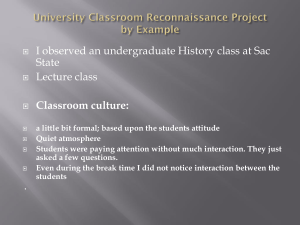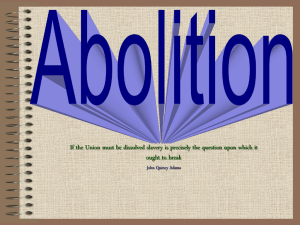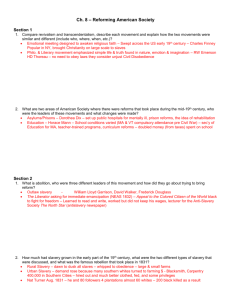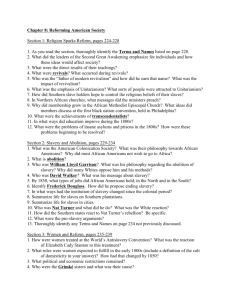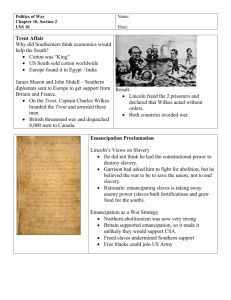Historical Investigation: George Washington's Changing Views of
advertisement
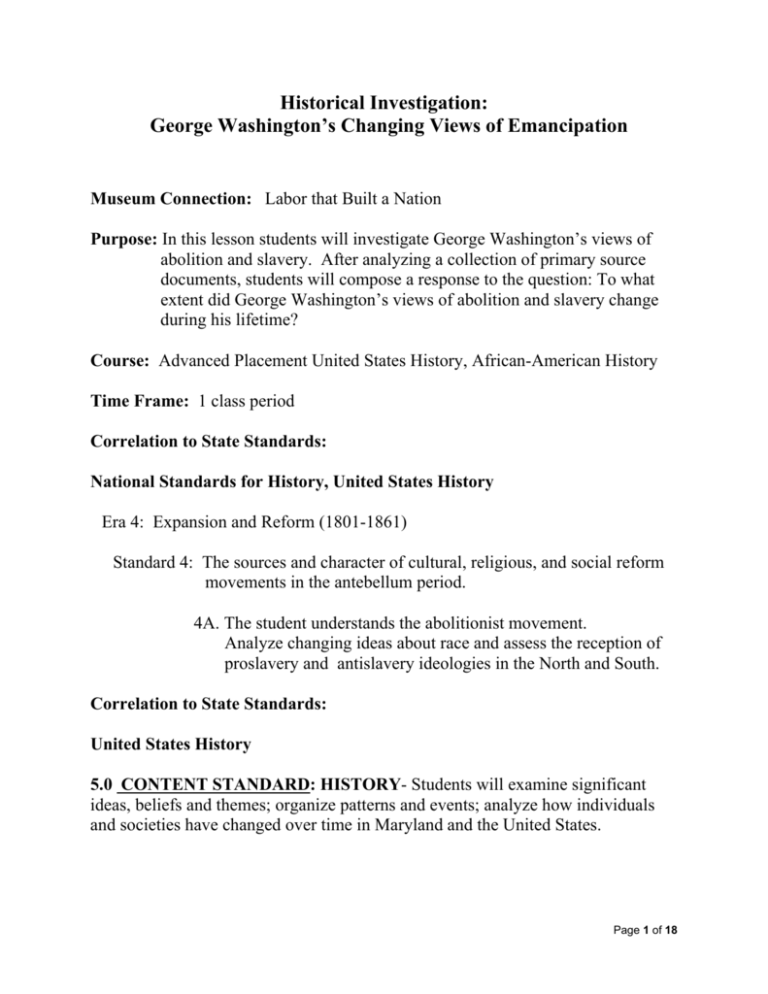
Historical Investigation: George Washington’s Changing Views of Emancipation Museum Connection: Labor that Built a Nation Purpose: In this lesson students will investigate George Washington’s views of abolition and slavery. After analyzing a collection of primary source documents, students will compose a response to the question: To what extent did George Washington’s views of abolition and slavery change during his lifetime? Course: Advanced Placement United States History, African-American History Time Frame: 1 class period Correlation to State Standards: National Standards for History, United States History Era 4: Expansion and Reform (1801-1861) Standard 4: The sources and character of cultural, religious, and social reform movements in the antebellum period. 4A. The student understands the abolitionist movement. Analyze changing ideas about race and assess the reception of proslavery and antislavery ideologies in the North and South. Correlation to State Standards: United States History 5.0 CONTENT STANDARD: HISTORY- Students will examine significant ideas, beliefs and themes; organize patterns and events; analyze how individuals and societies have changed over time in Maryland and the United States. Page 1 of 18 Expectation 5.1: Students will demonstrate understanding of the cultural, economic, political, social and technological develops from Reconstruction to 1897. 1. Analyze the economic, political and social consequences of Reconstruction (5.1.1). Objective: b. Evaluate the power struggle between the executive and legislative branches at the national level during Reconstruction, such as Presidential v. Congressional Reconstruction Plans. Common Core State Reading Standards for Literacy in History/Social Studies 6-12 • Cite specific textural evidence to support analysis of primary and secondary sources, attending to such features as the date and origin of the information. Common Core State Writing Standards for Literacy in History/Social Studies 6-12 • Write informative/explanatory texts, including the narration of historical events, scientific procedures/experiments, or technical processes. • Draw evidence from informational texts to support analysis, reflection, and research. Objective: Students will determine the causes and the degree to which George Washington’s view of abolition changed during his lifetime. Vocabulary: Abolitionist Abolitionist Movement emancipation manumission a person who works to end slavery. an organized effort of individuals (both African American and white) and organizations to end slavery in the United States of America. the freeing of slaves. emancipation of an individual slave through any one of a variety of legal means. Page 2 of 18 Materials: For the Teacher: Vocabulary Publications Websites Historical Background Painting: “George Washington at Mount Vernon” For the Students: Painting: “George Washington at Mount Vernon” Student Resource Sheet 1, “Individual Analysis” Student Resource Sheet 2, “Group Analysis” Student Resource Sheet 3, “Maryland Gazette article with transcript” Student Resource Sheet 4, “Correspondence between Washington and the Marquis de Lafayette” Student Resource Sheet 5, “Last Will and Testament of George Washington” Resources: Publications: Burns, James MacGregor and Susan Dunn. George Washington. New York: Times Books, 2004. “Slavery at Mount Vernon.” Footsteps November/December 2000. Levy, Andrew. First Emancipator: The Forgotten Story of Robert Carter the Founding Father who Freed his Slaves. New York: Random House, 2005. Wiencek, Henry. An Imperfect God: George Washington, His Slaves, and the Creation of America. New York: Farrar, Straus and Giroux, 2003. Web Sites: http://teachingamericanhistory.org/library/index.asp?documentprint=36 http://gwpapers.virginia.edu/slavery/advertiseimage.html Page 3 of 18 Historical Background: George Washington’s views of slavery were shaped by contemporary views of race relations. The question for this lesson is: “How did Washington’s views of slavery and emancipation change over time?” In modern society it is generally agreed that racism and prejudice are not and should not be a part of the American social and political fabric. However, in 1787 that was not the case. Those founding fathers and others who believed in the brotherhood of humanity and the injustice of slavery were in the minority. Yet, there were those who held such beliefs. Why didn’t Washington embrace these beliefs? The early beginnings of the abolitionist movement in the United States lend some insight into this question. Robert Carter, a Virginian like Washington, caused a great controversy when he opposed the prevailing racial attitudes of the day and freed five hundred of those he held in bondage. Carter took the position that it was hypocritical to fight against the British for their “enslavement” of the colonists and for them to engage in such behavior. Moreover, on religious grounds, he believed that God would punish the newly formed nation for their hypocrisy. Washington, on the other hand, did not free those he enslaved until after his death. Washington may have been influenced by the Great Awakening and the acceptance of his own mortality in providing conditional emancipation for the majority of those he enslaved at Mount Vernon. It is important for us to understand that Washington was operating within the context of the early abolitionist period when he was considering emancipating those he enslaved. Lesson Development: Motivation: Look at the painting of George Washington at Mount Vernon. After examining the painting, answer the questions that follow. Page 4 of 18 Painting: Life of George Washington the Farmer by James Brutus Stearns (1851) Source: Library of Congress Prints and Photographs Division, Washington DC teachingamericanhistory.org/convention/stearns/ 1. What does this painting tell us about George Washington? 2. What does this painting tell us about the period in which Washington lived? (Note to teacher: This image reflects the position of Washington as elite. He is depicted as the head of his family which includes immediate family members and those who work for him. To that extent this image could be considered a “family” portrait with Washington at the head pointing to his subjects and workers. It was typical during this period in American history for economic activity to be centered at home, thus Washington’s depiction adds insight into the economic relations of members of the social order. While the focus of the lesson is on Washington’s changing views on abolition and slavery, any examination of this image must also Page 5 of 18 probe the lives of those enslaved. Who are they? What relationships do they have with each other? Where are their children)? 2. Read the narrative to the class, stressing the focus question at the end. George Washington lived during a time when slavery was an “accepted” practice for most Americans. His father’s death made him an owner of 10 slaves when he was only 11 years old. Like most people of the Virginia gentry, he believed that the only way to be successful was to own land. Owning that land, however, was not enough. That land had to be cultivated and made useful. In order to do that, Washington and his peers turned to enslaved Africans for their labor force. Washington possessed approximately 75 slaves between 1743 and 1775. Some he inherited from his father; his 1759 marriage to Martha Custis provided him with access to 25 more. He used their labor to establish successful farming operations at Mount Vernon and his other farms. By the time of his death, his estate included 317 enslaved people, 124 of whom were his property outright, 153 who were Martha Washington’s dower slaves, and 40 whom he had leased from a neighbor. Washington’s landholdings were vast. In addition to Mount Vernon, he owned and operated four additional farms. Since each farm was a separate entity, the slave labor force on each had to be diversified in order to make the operations successful. Because 132 of his 317 enslaved laborers were either too old or too young to work, Washington’s five farms were actually staffed by only 184 people. Of those 184, 52 were considered skilled artisans or domestic workers. The work of skilled artisans such as coopers, blacksmiths, bricklayers, carpenters, and distillers were essential to the everyday operation of plantations. Domestic workers included butlers, maids, cooks, and waiters. Most of Washington’s enslaved population, however, were field workers. Like many of the Founding Fathers, Washington had conflicting feelings over the institution of slavery. Despite never having made a public stand on the issue during his lifetime, he left behind a will that served as an example of his changed beliefs. In his 1799 will, he made provisions for the emancipation of all of his slaves. Washington gave immediate freedom to his body servant, Billy Lee. He was one of Washington’s close and loyal personal servants. The remaining slaves were to be emancipated after his wife’s death. What caused Washington to do this? To what extent did Washington’s view of abolition change during his lifetime? In this Historical Investigation, we will Page 6 of 18 look at documents that will enable us to see the evolution of George Washington’s opinion of abolition and the institution of slavery. 3. Implement the following historical investigation. Focus Question: To what extent did George Washington’s view of emancipation change over time? I. Conduct the Investigation In order to answer the question we will examine Student Resource Sheets 3, 4, and 5 independently. Analyze each document by answering the following questions on Student Resource Sheet 1: Individual Analysis Graphic Organizer 1. 2. 3. 4. Clarify historical context. (Who, What, When, Where) Explain the author’s point of view. (Why was the document authored?) How do we know this document is a reliable source? How can this document help me answer the focus question? (Is this relevant to my investigative question? How does it stand up against other sources?) II. Discussion: Now that the documents have been analyzed, we will have the opportunity to discuss them and the focus question with students in your group. As we discuss interpretations of the documents, cite evidence for opinions. Multiple interpretations can emerge and may or may not be accepted by all. Write your group responses in the appropriate section of Student Resource Sheet 2: Group Analysis Graphic Organizer. Assessment: Once historians complete their research, they formulate a thesis that answers the focus question. We will do the same. Your summary should answer the focus question below and be supported with details from the documents. Focus Question: To what extent did Washington’s view on abolition change during over time? Page 7 of 18 Closure: Conclude the lesson by having students share their findings. Encourage students to discuss varying perspectives and to provide evidence from the documents to support their assessment of Washington’s changing views on abolition and slavery. Thoughtful Application: 1. Ask students to describe how their opinions or the opinions of others have changed over time or as they learned more about a topic or group. 2. Examine ideas that were once unpopular but are largely accepted in today’s society (abortion, homosexuality, etc.). Compare and contrast the factors that caused the shift over time from unpopular to acceptable. 3. Have students place Washington’s change of view on the political spectrum from conservative to liberal and justify their opinions with historical references. Lesson Extensions: 1. The Museum offers several school programs that connect to the curriculum lessons. o Journey in History Theater provides living history and theatrical performances which highlight African Americans in the museum’s gallery. o Take the theme tour, Paths to Freedom and explore the story of slavery through the eyes of enslaved and free blacks from Maryland’s colonial past to the end of the Civil War. o Contact group reservations for schedule updates. 2. Visit the Strength and Mind gallery of the Reginald F. Lewis Museum of Maryland African American History and Culture. Examine the letters Benjamin Banneker and Thomas Jefferson wrote to each other concerning the intellect of African Americans. Did Jefferson concur with Banneker’s views on Page 8 of 18 3. 4. 5. 6. 7. black intellect? Research Jefferson’s position on African Americans and freedom. Harriet Beecher Stowe wrote the antislavery novel, Uncle Tom’s Cabin which was based on Josiah Henson’s account of his life as a slave. Research how Uncle Tom’s Cabin impacted America’s view on slavery. Conduct further research on Robert Carter and the story of how he manumitted the people he once enslaved on his plantation. Examine the debates in northern states over how to abolish slavery (immediacy v. gradual emancipation). Conduct further research on the development of the abolitionist movement in the United States. Examine the role of African American abolitionists and how they sought to abolish slavery. Compare their positions and activities with that of white abolitionists. Page 9 of 18 Student Resource Sheet 1 Individual Analysis Focus Question: TO WHAT EXTENT DID GEORGE WASHINGTON’S VIEWS OF EMANCIPATION CHANGE OVER TIME? Clarify historical context. (Who, what when, where) Explain the author’s point of view How do we know this document is a reliable source? How can this document help me answer the focus question? Document 1 Document 2 Page 10 of 18 Focus Question: TO WHAT EXTENT DID GEORGE WASHINGTON’S VIEWS OF EMANCIPATION CHANGE OVER TIME? Clarify historical context. (Who, what when, where) Explain the author’s point of view How do we know this document is a reliable source? How can this document help me answer the focus question? Document 3 Page 11 of 18 Student Resource Sheet 2 Group Analysis Focus Question: TO WHAT EXTENT DID GEORGE WASHINGTON’S VIEWS OF EMANCIPATION CHANGE OVER TIME? Clarify historical context. (Who, what when, where) Explain the author’s point of view How do we know this document is a reliable source? How can this document help me answer the focus question? Document 1 Document 2 Document 3 Page 12 of 18 Student Resource Sheet 3 Document 1: Maryland Gazette (Annapolis), 20 Aug. 1761 Original image Page 13 of 18 Student Resource Sheet 3 Document 1 Maryland Gazette (Annapolis), 20 Aug. 1761 Transcript Advertisement for Runaway Slaves Printed in Maryland Gazette (Annapolis), 20 August 1761 by George Washington Fairfax County (Virginia) August 11, 1761. Ran away from a Plantation of the Subscriber's, on Dogue Run in Fairfax, on Sunday the 9th Instant, the following Negroes, [1] viz. Peros, 35 or 40 Years of Age, a well-set Fellow, of about 5 Feet 8 Inches high, yellowish Complexion, with a very full round Face, and full black Beard, his Speech is something slow and broken, but not in so great a Degree as to render him remarkable. He had on when he went away, a dark colour'd Cloth Coat, a white Linen Waistcoat, white Breeches and white Stockings. [2] Jack, 30 Years (or thereabouts) old, a slim, black, well made Fellow, of near 6 Feet high, a small Face, with Cuts down each Cheek, being his Country Marks, his Feet are large (or long) for he requires a great Shoe: The Cloathing he went off in cannot be well ascertained, but it is thought in his common working Dress, such as Cotton Waistcoat (of which he had a new One) and Breeches, and Osnabrig Shirt. [3] Neptune, aged 25 or 30, well set, and of about 5 Feet 8 or 9 Inches high, thin jaw'd, his Teeth stragling and fil'd sharp, his Back, if rightly remember'd, has many small Marks or Dots running from both Shoulders down to his Waistband, and his Head was close shaved: Had on a Cotton Waistcoat, black or dark colour'd Breeches, and an Osnabrig Shirt. [4] Cupid, 23 or 25 Years old, a black well made Fellow, 5 Feet 8 or 9 Page 14 of 18 Inches high, round and full faced, with broad Teeth before, the Skin of his Face is coarse, and inclined to be pimpley, he has no other distinguishable Mark that can be recollected; he carried with him his common working Cloaths, and an old Osnabrigs Coat made Frockwise. [5] The two last of these Negroes were bought from an African Ship in August 1759, [6] and talk very broken and unintelligible English; the second one, Jack, is Countryman to those, and speaks pretty good English, having been several Years in the Country. The other, Peros, speaks much better than either, indeed has little of his Country Dialect left, and is esteemed a sensible judicious Negro. As they went off without the least Suspicion, Provocation, or Difference with any Body, or the least angry Word or Abuse from their Overseers, [7] 'tis supposed they will hardly lurk about in the Neighbourhood, but steer some direct Course (which cannot even be guessed at) in Hopes of an Escape: Or, perhaps, as the Negro Peros has lived many Years about Williamsburg, and King William County, and Jack in Middlesex, they may possibly bend their Course to one of those Places. Whoever apprehends the said Negroes, so that the Subscriber may readily get them, shall have, if taken up in this County, Forty Shillings Reward, beside what the Law allows; and if at any greater Distance, or out of the Colony, a proportionable Recompence paid them, by George Washington. N.B. If they should be taken separately, the Reward will be proportioned. http://gwpapers.virginia.edu/document/slavery/aug1761.html Page 15 of 18 Student Resource Sheet 4 Document 2: Correspondence between Washington and the Marquis de Lafayette Lafayette to Washington February 5, 1783 “Now, my dear General, that you are going to enjoy some ease and quiet, permit me to propose a plan to you, which might become greatly beneficial to the black part of mankind. Let us unite in purchasing a small estate, where we may try the experiment to free the negroes, and use them only as tenants. Such an example of yours might render it a general practice; and if we succeed in America, I will cheerfully devote a part of my time to render the method fashionable in the West Indies. If it be a wild scheme, I had rather be mad this way, than to be thought wise in the other task.” Lafayette to Washington July 14, 1786 “I have purchased for Hundred and twenty-five thousand French livers a plantation in the Colony of Cayenne and am gong to free my negroes in order to make that Experiment which you know as My Hobby Horse.” Washington to Lafayette May 1786 “The benevolence of your heart…is so conspicuous upon all occasions, that I never wonder at any fresh proofs of it; but your late purchase of an estate in the colony of Cayenne, with a view of emancipating the slaves on it, is a generous and noble proof of your humanity. Would to God a like Spirit would diffuse itself generally into the minds of the people of this country; but I despair of seeing it. Some petitions were presented to the Assembly, at its last Session, for the abolition of slavery, but they would scarcely obtain a reading. To set them afloat at once would, I really believe, be productive of much inconvenience and mischief; but by degrees it certainly might, and assuredly ought to be effected; and that too by Legislative authority.” http://academicmuseum.lafayette.edu/special/specialexhibits/slaveryexhibit/onlineexhibit/wildsc heme.htm Page 16 of 18 Student Resource Sheet 5 Document 3: Last Will and Testament of George Washington July 9, 1799 I GEORGE WASHINGTON of Mount Vernon, a citizen of the United States, and lately President of the same, do make, ordain and declare this Instrument; which is written with my own hand and every page thereof subscribed with my name, to be my last Will & Testament, revoking all others. *** Item Upon the decease of my wife, it is my Will and desire, that all the slaves which I hold in my own right, shall receive their freedom. To emancipate them during her life, would, tho’ earnestly wished by me, be attended with such insuperable difficulties on account of their intermixture by Marriages with the Dower Negroes, as to excite the most painful sensations, if not disagreeable consequences from the latter, while both descriptions are in the occupancy or the same Proprietor; it not being in my power, under the tenure by which the Dower Negroes are held, to manumit them. And whereas among those who will receive freedom according to this devise, there may be some, who from old age or bodily infirmities, and others who on account of their infancy, that will be unable to support themselves; it is my Will and desire that all who come under the first and second description shall be comfortably clothed and fed by my heirs while they live; and that such of the latter description as have no parents living, or if living are unable, or unwilling to provide for them, shall be bound by the Court until they shall arrive at the age of twenty-five years; and in cases where no record can be produced, whereby their ages can be ascertained, the Judgment of the Court, upon its own view of the subject, shall be adequate & final. The Negroes thus bound, are (by their Masters or Mistresses), to be taught to read and write; & to be brought up to some useful occupation, agreeably to the Laws of the Commonwealth of Virginia, providing for the support of orphan & other poor Children. And I do hereby expressly forbid the sale, or transportation out of the said Commonwealth of any Slave I may die possessed of, under any pretence whatsoever. And I do moreover most pointedly, and most solemnly enjoin it upon my Executors hereafter named, or the survivors of them, to see that this clause respecting Slaves, and every part thereof be religiously fulfilled at the Epoch at which it is directed to take place; without evasion, neglect or delay, after the Crops which may then be on the ground are harvested, particularly as it respects the aged & infirm; Seeing that a regular & permanent fund be established for their support so long as there are Page 17 of 18 subjects requiring it; not trusting to the uncertain provision to be made by individuals. And to my Mulatto man, William (calling himself William Lee) I give immediate freedom; or if he should prefer it (on account of the accidents which have befallen him, and which have rendered him incapable of walking or of any active employment.) to remain in the situation he now is, it shall be optional in him to do so: In either case however, I allow him an annuity of thirty dollars during his natural life, which shall be independent of the victuals and clothes he has been accustomed to receive, if he chooses the last alternative: but in full with his freedom, if he prefers the first: & this I give him as a testimony of my sense of his attachment to me, and for his faithful services during the Revolutionary War. http://teachingamericanhistory.org/library/index.asp?documentprint=36 Page 18 of 18
